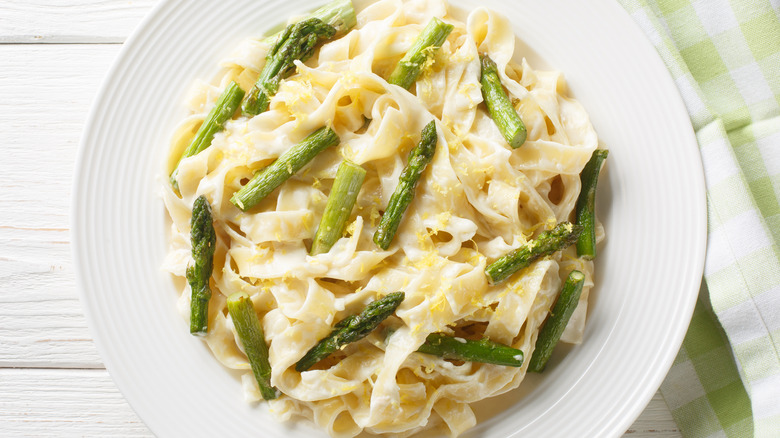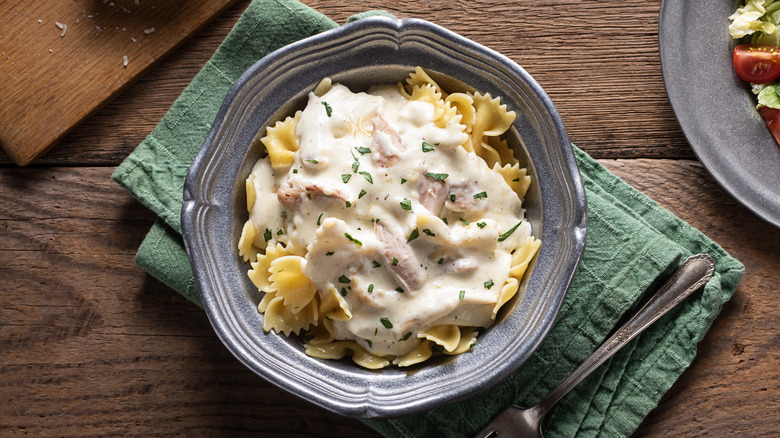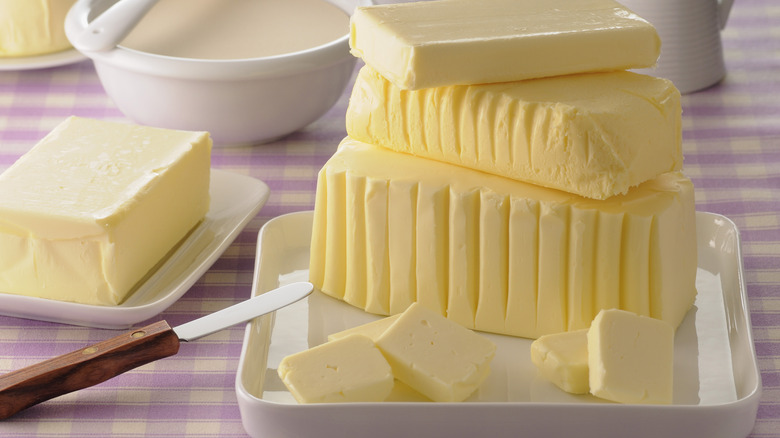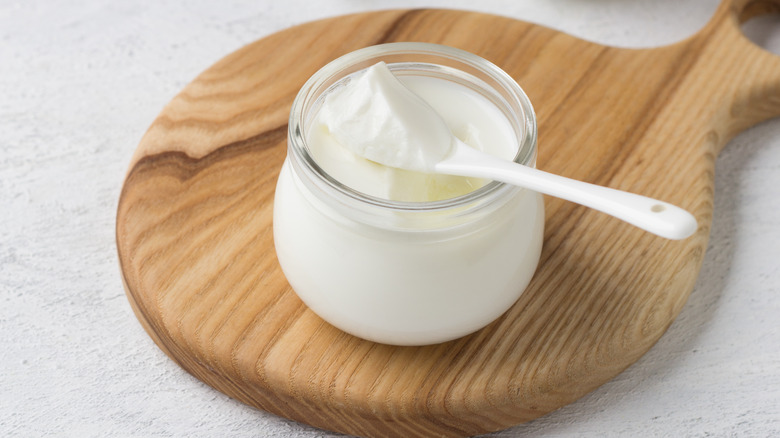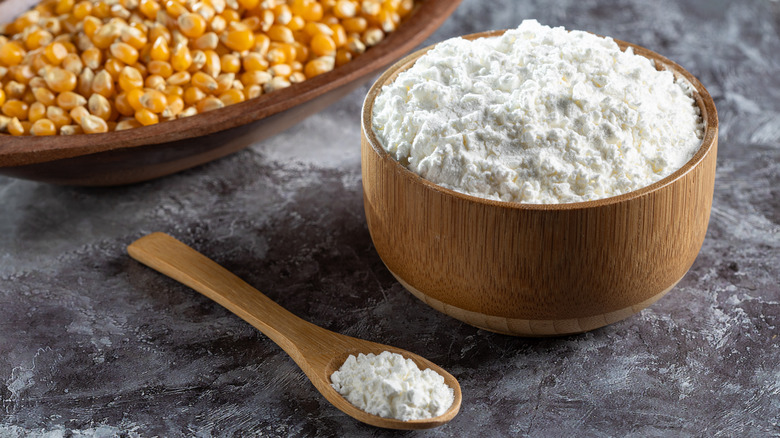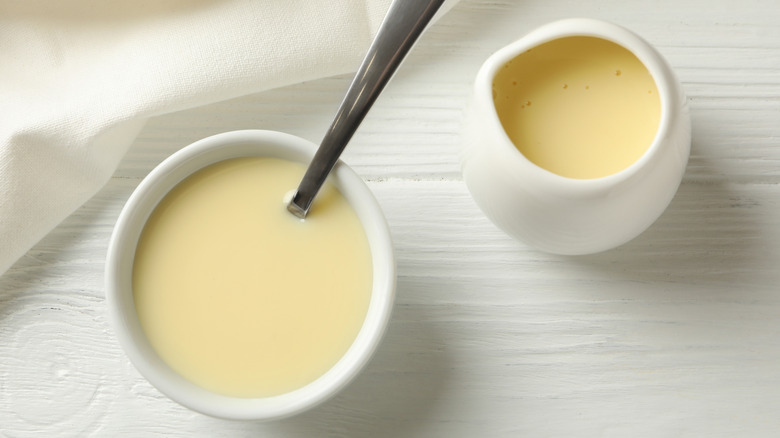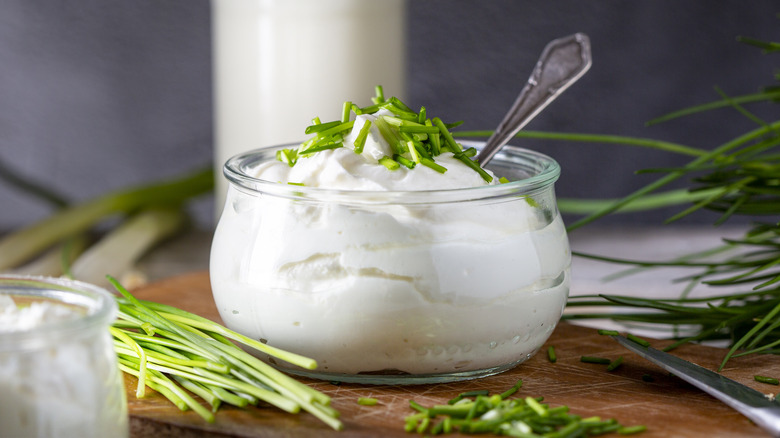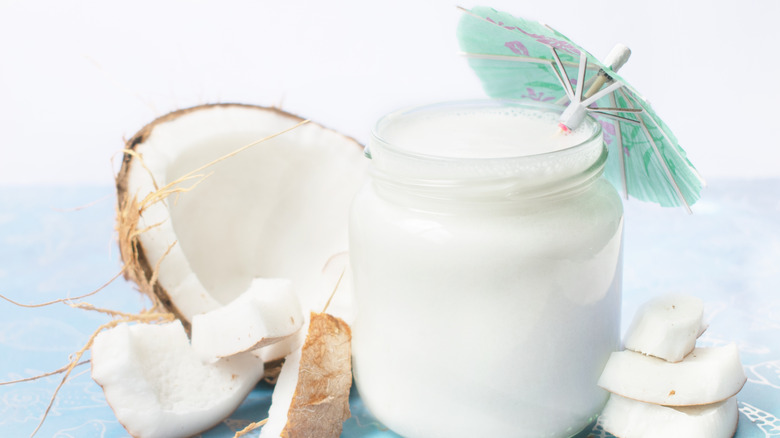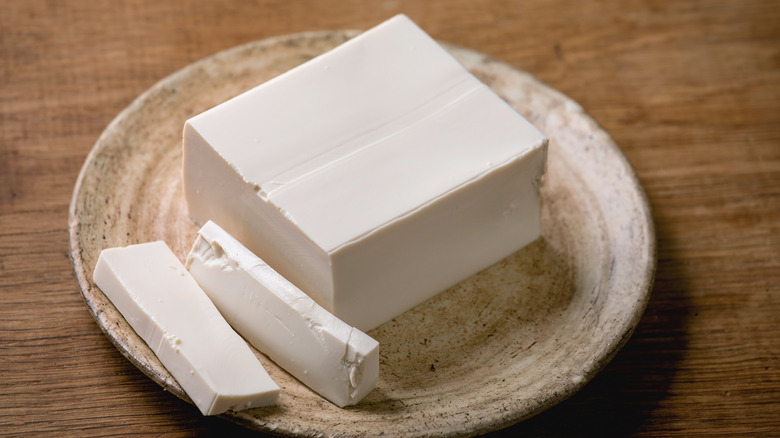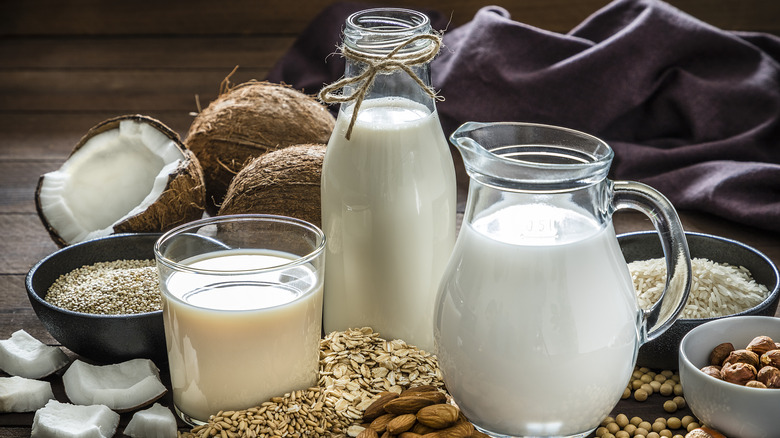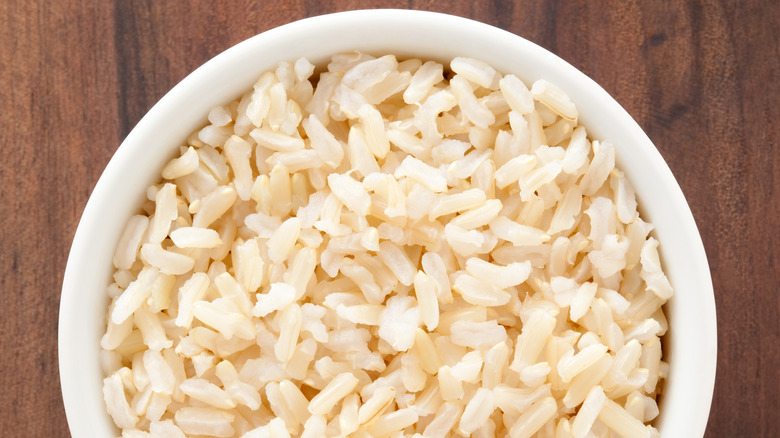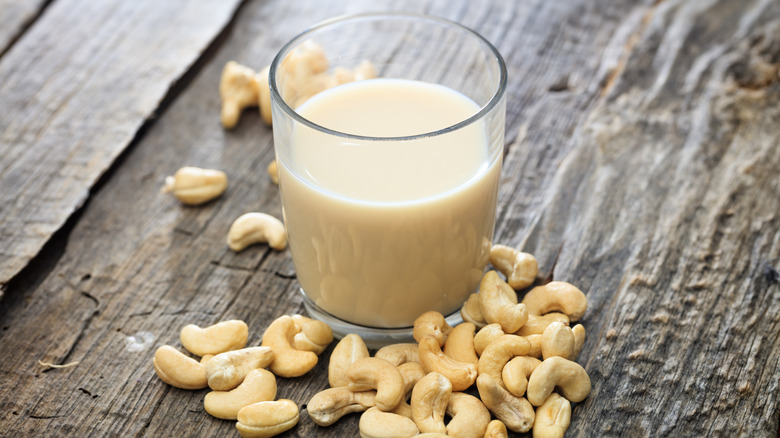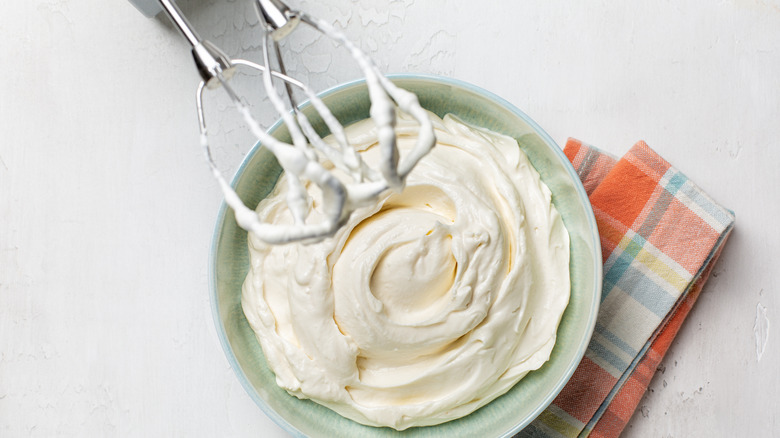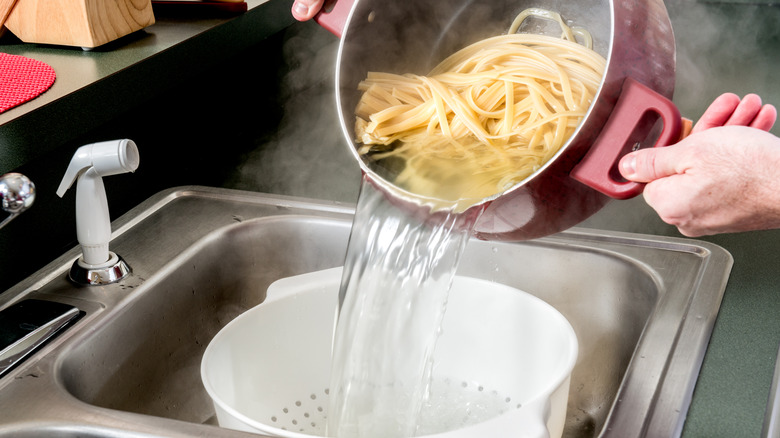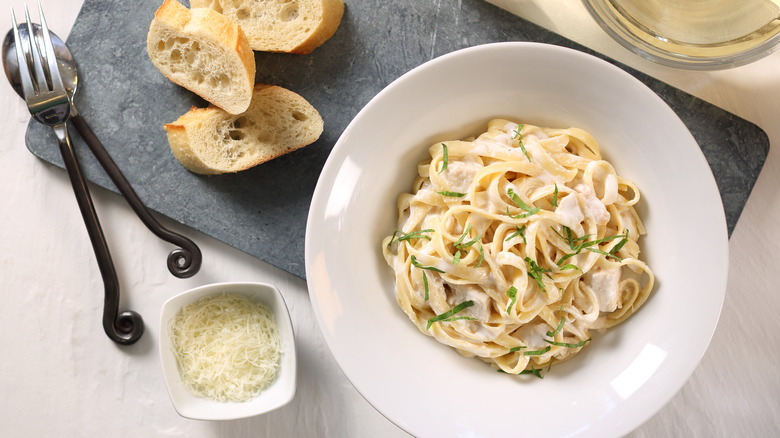The 14 Best Substitions For Heavy Cream In Pasta Sauce
As celebrity chef Ina Garten might say, "good" heavy cream is a fixture in countless recipes. From desserts and drinks to soups and pasta sauces, there's nothing quite like cream to add a rich, beautiful, velvety texture to a finished dish, no matter what pasta shape floats your boat. As such, you might expect the average American cook to keep heavy cream on hand at all times.
Maybe, however, you're out, or you forgot to buy some, or you put the last of it in the mashed potatoes ... and now you don't have time to run to the store to replace it. Perhaps you just didn't realize that someone put the last bit of it in their coffee until you needed it for your pasta salad or fettuccini Alfredo. What's the average American cook to do? The good news is, there are quite a few substitutions out there for heavy cream in pasta sauce.
I've tried almost all of them over the years, with a lot of help from the bloggers of the world. You can read more about how I determined my rankings at the end of this list, but for now, let's jump right in.
1. Half-and-half
Half-and-half, by dint of being half cream and half milk, naturally carries a lot of that heavy-cream goodness with it. Since the other half of the mixture is usually whole milk, which is also plenty creamy, this is a great substitute for heavy cream in pasta recipes.
Due to half-and-half's lower fat content, though, it carries a high chance of curdling. Essentially, dairy products contain both fat and protein. Curdling occurs when proteins lump together inside the suspension liquid, causing lumps. This is often caused by the presence of acid, which makes proteins more attractive to one another. In fattier products like cream, the fat can prevent this by coating the proteins, which is why you can straight-up boil cream but boiling milk will curdle it.
To combat this issue, you can add half-and-half at the end of your pasta sauce recipe, which is often when dairy products are added anyway. Alternatively, if you're meant to simmer the sauce for a while, make sure you cook it over low heat.
2. Milk plus butter
Heavy cream is essentially milk with more fat, so if you're out of it, you can add some butter to regular milk to approximate the same effect. Would you want to drink this in your coffee? No, probably not, because the butter would separate in a weird way, but on the other hand, if you've ever put actual cream in your coffee rather than half-and-half, you likely also noticed an oily effect there. Fat is fat.
Point being, milk and butter do an excellent job of replicating heavy cream when cooked into a warm sauce with other ingredients. To make the switch, combine melted butter and milk in a 1:3 ratio (for example, ¼ cup butter and ¾ cup milk), then stir together. Whole milk is a great way to go, since it has a higher fat content than 2% or skim varieties; however, if you only have skim or part-skim milk, you can stir in 1 tablespoon of flour to compensate for that missing thickness.
3. Greek yogurt
Famously thick, Greek yogurt works well as a heavy-cream substitute in all kinds of recipes, including soups and pasta sauces. It's also deliciously tangy and pairs well with tomatoes, olives, and aged cheeses. You know something works well as a substitute when some recipes call for it in its own right; there are plenty of pasta sauce recipes that call for Greek yogurt, combining it with elements like garlic and lemon or parsley and parmesan.
Better yet, it's a cinch to sub in. While some sources claim you should mix equal parts Greek yogurt and milk to make up the amount needed, others say you can simply use a 1:1 substitution ratio. Still others advise starting with 1 cup of Greek yogurt and ¼ cup milk, then adding more milk until you reach your preferred level of creaminess. How thick you want your pasta sauce to be is up to you; just know that more yogurt will mean a thicker sauce in the end. (If you only have Greek yogurt on hand and don't want an overly thick sauce, you can learn more about loosening it in our pasta water entry.)
4. Milk plus cornstarch
Cornstarch is renowned for its thickening powers. While it can't give whole milk the same fatty quality as heavy cream, meaning your sauce won't be quite as rich and velvety at the end, the "starch" part of cornstarch means it does absorb liquid quite well. Adding it to your milk will lend that luxurious, creamy mouthfeel while tightening up the sauce as a whole and helping it stick to your noodles more effectively. Plus, cornstarch is flavorless, so you can add it without worrying about changing the taste of your dish.
The correct ratio is 2 tablespoons of cornstarch to 1 cup of milk. The easiest way to avoid clumps is to add the milk to the cornstarch slowly while whisking continuously. Doing the reverse will cause the mixture to seize up, and you'll be stuck with clumps unless you break out your blender. Note also that cornstarch needs heat to kick off its gelatinization process, so make sure your mixture comes to a high simmer, at least 203 degrees Fahrenheit. If you need to add your heavy-cream substitute to a cold dish like pasta salad, cook it separately and let it cool.
5. Evaporated milk
Evaporated milk is just what it sounds like: milk that's been subjected to heat until it loses a significant amount of its water — about 60% of its overall water content, to be exact. As such, evaporated milk is much thicker than regular milk, making it a suitable substitute for cream. When adding it to pasta recipes, use a 1:1 ratio.
Make sure, though, that you know the difference between evaporated milk and condensed milk. While both options are thickened milk products that have had the same percentage of water removed, condensed milk also contains sweetener. Chances are good (excellent, in fact) that your noodles won't benefit from a boatload of added sugar. While some pasta recipes do call for a bit of sugar to balance the acidity in tomato sauce, most cream-based sauces are already sweet, so say, "No, grazie," to condensed milk.
Evaporated milk has a sweet flavor all its own because dairy itself tastes sweet. If you open a can and taste it, you'll notice it has a rich taste comparable to a coffee creamer, which is how some people use it. As such, you might want to taste it before you dump the full amount into your sauce.
6. Cream cheese
Cream cheese is another dairy product that will work if you don't have any heavy cream on hand. Its neutral flavor and thick texture make it ideal for pasta sauces, which is why it's delicious on its own with tomato sauce and herbs or garlic and crushed red pepper. Because it doesn't have the tang of sour cream or the nutty flavors of alternative milk, it's a pretty ideal substitute.
The only drawback is that cream cheese is naturally thick and solid at room temperature, unlike actual cream, which is a liquid (albeit a viscous one). That means you'll need to tweak this sub a little. Don't worry — it's nothing a butter knife and a microwave can't handle. To soften 8 ounces of cream cheese, put the unwrapped block on a microwave-safe plate and zap it on high for 15 seconds. Add 10 seconds for each 8-ounce chunk of cream cheese, or as needed. You can also cut up the block to heat it quicker and achieve a more even softening effect.
If you're just going to add your cream cheese straight to the sauce at the end, feel free to skip this step, as the cheese will melt nicely anyway. Cutting it up will, however, speed up the melting process.
7. Sour cream plus milk
With its mild tang and rich, creamy mouthfeel, sour cream is a great substitute for its heavier counterpart. Indeed, some pasta sauce recipes call for sour cream in combination with jarred tomato sauce, a one-two combo that coats noodles perfectly and leads to a silky product. As such, you can definitely rely on it if your fridge is lacking any other dairy. The only factor to watch for is that tanginess, which blends nicely with wine or mushrooms but could be odd when paired with other flavors like fish.
When making this substitute, use ⅔ cup of sour cream and ⅓ cup of milk for each cup of heavy cream required. You can safely use alternative milk in pasta sauce if you don't have standard cow's milk, but be aware that some alternatives will lose their suspension (e.g., curdle) when exposed to heat. In any case, you should add your sour cream at the end. Make sure to mix it in slowly and stir constantly, as this is one of the best ways to prevent curdling (the same goes for any of the dairy types on this list).
8. Coconut cream
You've reached the first vegan substitution on the list. Congratulations! Depending on your dietary needs, you've finally reached the good part. Seriously, though, coconut cream is a wonderful substitute for heavy cream, as the two are very similar in consistency. It'll work in everything from Alfredo sauce to chilled pasta salad. You can even whip it, provided you chill it and drain off all the liquid (otherwise, this liquid will change your sauce's consistency). While you probably won't put that fact to use for pasta sauce, it's still good to know.
Happily, while coconut cream looks bizarrely solid in the can, it's nearly indistinguishable from standard cream once you melt it into a sauce. The only thing to watch out for is flavor, as some kinds of coconut cream taste like exactly what they are, while others don't. Experiment with varieties to find ones that are less coconut-forward. (I find that Trader Joe's and Whole Foods' brands are both pretty neutral, but everyone is different.) Some people, however, like the flavor of coconut in pasta sauce, so feel free to explore.
9. Silken tofu
Believe it or not, silken tofu is great in pasta sauce. It's also a great dairy substitute because it becomes super smooth (hence the name) and has a satisfyingly protein-rich yet neutral flavor. For this reason, you'll find it in plenty of pasta sauces that use roasted red pepper or lemon and nutritional yeast, among other spins. Plus, it majorly boosts your pasta's protein content, contributing 4 grams per serving for only 40 calories.
Why should you make silken tofu your new best friend, pasta or otherwise? Because it can transform from a jiggly, pudding-like bean curd into something that strongly resembles its namesake: silk. If you're out of heavy cream or simply want an alternative, then this is a great substitution. It won't whip, but that's true of most substitutes on this list (minus coconut cream), and besides, few people want whipped cream in their pasta, anyway.
To use silken tofu in pasta recipes, sub it in using a 1:1 ratio. That said, don't simply dump tofu into your sauce, as this will prevent it from disappearing into the liquid. Instead, you should first puree it in a blender or food processor. If your sauce recipe calls for stirring together heavy cream with other ingredients, then this is a good time to add those ingredients to the tofu and blend them together.
10. Alternative milk plus oil
If you want to venture a bit farther afield in your quest for cream substitutes, either because you're working with a limited pantry or because you're vegan, then try alternative milk with some oil. The correct ratio is ⅔ cup of alt milk and ⅓ cup of oil, preferably a neutral variety like vegetable or safflower. Although this will work for any alternative milk, one of the creamiest types is oat. Cashew milk is also creamy, and while almond is more watery, it has a neutral flavor that works well in pastas of all varieties.
As discussed above, alternative milks curdle at different rates. Almond and soy milk are likelier to curdle when exposed to heat, while you can freely pour oat milk into the most scalding coffee and it'll remain creamy like a champ. Oats do have a more pronounced flavor that can only be described as "oat-y," but it's delicious and creamy, nevertheless.
11. Brown rice plus milk
If your reaction to the idea of replacing heavy cream with brown rice is something along the lines of "Really?" or "Gross," then I have the greatest of sympathy. I grew up eating far too much brown rice when there was perfectly nice white rice lying around at, like, every single grocery store. That said, brown rice is a wonderful substitute for heavy cream because it's rich, binding, and flavorful without being overwhelming. You simply cook it, then blend it with milk to create a thick, creamy substitute.
Even better news: The recipe is quite easy. Combine 2 cups of water (or broth) in a pan with ½ cup of instant brown rice. Bring it to a boil, reduce the heat to low, cover it, and then simmer for 25 minutes. After the rice cools for 5 minutes, blend the mixture with 1 cup of milk, then add it to your sauce. Some sources say the concoction won't curdle like other substitutes, but it's a good idea to be wary of the milk and either add it at the end or cook it on low.
12. Cashew cream
Beloved for its ability to mimic nacho cheese with reasonable accuracy, cashew cream is a fabulous dairy substitute in just about anything. If you're not yet using cashew cream in your cooking, you should be. It works great in soups, aiolis, casseroles, curries, and more.
And guess what? It works just as well with pasta, blending into a substance that's as smooth as cream and that won't curdle in the presence of acids like those contained in lemon or tomato. Moreover, it's super easy to make.
All you have to do is soak 1 cup of cashews in cold water for 2 hours, making sure the water covers the cashews completely. You might need to prod some to the bottom when you first pour the water over them (and don't worry if your water comes from the tap). Then, just strain the nuts, mix them with ¾ cup filtered water, add a bit of salt, and blend them until everything comes together in a smooth, lump-free sauce. At that point, you can stir it into your pasta sauce.
13. Heavy cream powder
Anyone who was exposed to powdered milk in their childhood can be forgiven for looking askance at heavy cream powder — that pale blue liquid was just a little too scarring to forget. Luckily, heavy cream powder is a whole different animal from powdered milk. It's much richer and thicker, and it's an overall better mimic of the food it's meant to approximate.
If you want to make sure you're never caught without heavy cream again, keep heavy cream powder on hand. It's dehydrated, so it won't go bad. It is expensive, about $14 for 12 ounces, but a little goes a long way. To make roughly 1½ cups of heavy cream, blend a cup of water with ⅜ cup of heavy cream powder, then let the mixture sit in the fridge overnight to thicken up. Best of all, the powder will last a couple of years in the cupboard if it's sealed and stored properly.
14. Pasta water
It would be irresponsible to conclude this post without giving a nod to pasta water, the most magical ingredient you never have to work for. Pasta water doesn't bring a lot of that heavy-cream richness to the table, but in a pinch, it's certainly better than nothing. It not only imparts flavor from both the pasta and the salt (which you should always add before boiling it), but the starches released into the cooking liquid will help bind your sauce together so that it sticks to the noodles.
This is because starches absorb liquid, so if your sauce is still a bit runny (not uncommon if you're using tomatoes or other juicy ingredients), pasta water can save the day. This water can also work the other way and loosen up your pasta sauce so it adheres to every nook and cranny of your noodles. This is the real reason you should always use pasta water, so make sure you set aside a cup before you drain. If you want to further increase the interest level of your dish, consider cooking pasta in liquids other than water, and then adding the resulting broth to your sauce at the end.
Methodology
I've tried pretty much everything on this list to cut calories, make up for missing ingredients, go dairy-free, or all of the above; however, at Chowhound, we rely on the experts. This list was curated from health sites, professional chefs, and bloggers. Substitutes only made the cut if they were recommended by multiple sources in the top 10 search rankings, and they're ordered here based on their similarity to actual heavy cream.
